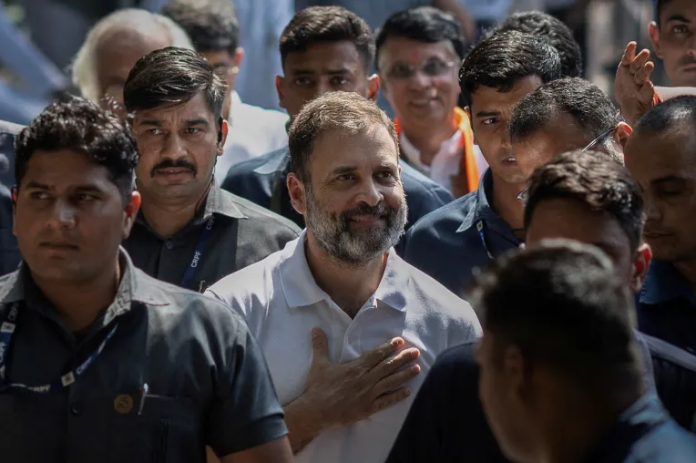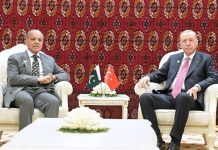DM Monitoring
New Delhi: Indian Congress leader Rahul Gandhi has blasted Prime Minister Narendra Modi’s government for unrest in Manipur.
Rahul Gandhi was addressing a public gathering in his constituency Wayanad, a day after the conclusion of the stormy monsoon session of Parliament.
Women and children are dying over there, women are being molested and raped and the Prime Minister of India is sitting in the middle of Parliament and doing nothing, he added.
This was Gandhi’s his first visit to his constituency after being reinstated as the MP on August 7 in the wake of the Supreme Court’s August 4 order staying his conviction in a defamation case.
Gandhi delivered the address after months of violence in Manipur in which at least 150 people have been killed, many hundreds more wounded and tens of thousands rendered homeless since May.
Rahul said PM Modi spoke for more than two hours while replying to the no-trust motion in the Lok Sabha on Thursday.
“PM laughed, joked and smiled. His Cabinet members laughed and smiled. They had a lot of fun. The Prime Minister spoke for two hours and thirteen minutes about everything, about the Congress, me, about INDIA alliance, but he spoke for only two minutes about Manipur.”
Addressing a gathering at a rousing reception in Wayanad’s Kalpetta, Rahul charged, “I said in Parliament a few days back that BJP has killed the idea of India in Manipur. What has happened in Manipur is murder of Bharat Mata. You have destroyed thousands of families, allowed rapes of women.”
On the other hand, With the May 3 violence leading to a massive loss of life and property, and a deeper sense of insecurity amongst the Kuki community, the ongoing political talks of the Kukis with the Union government have undergone a complete switch. Demands for a ‘separate administration’ for themselves have morphed into an assertion of ‘complete separation’ from the Manipur state.
In other words, the demand is now for statehood or a Union territory for the Kukis alone, borne out of the rage and fury of the community, directed towards the state government being seen to be led by N. Biren Singh, acting as a polarising figure for his own people, the Meiteis.
However, this growing demand will not only put the Kukis at odds with the Meitei community but also the Nagas in the neighbourhood, and is likely to rake up old festering disagreements between these communities around their different ideas about ‘traditional land’ in that northeastern state. If what is unfolding in the hills of Manipur is any indication, the ball has already started rolling.
Proposed Kuki state map?
As per reliable sources, the Indigenous Tribal Leaders’ Forum (ITLF), spearheading the demand, is set to hand over a proposed map of sorts to the Ministry of Home Affairs (MHA) around August 17. Such a move is not just novel but bold too, since the Kuki community leaders know well that Meties and Nagas would both contest it tooth and nail – ultimately complicating their goal for statehood.
As per sources in the Ministry of Home Affairs (MHA), the talks around the possibility of granting the Kuki community a territorial council under the Sixth Schedule were around Churachandpur, the Kuki-majority district of Manipur, and some Kuki-dominated strips of the Kangpokpi district.
However, if the Centre had granted the Sixth Schedule to a hill district of Manipur as reported in the first part of this series, it would have likely kicked up massive discontent within the Meities in the valley areas, fanning an already existing ‘fear’ within the majority community. The ‘fear’ usually spoken of is that 90% of the land would go out of the hands of the Meitei (majority) community in the state, and in the remaining 10%, there would be no restrictions on anyone else to settle.
This is fuelling the fight to maintain the ‘territorial integrity’ of the state. Manipur is no stranger to such sentiment, and in the past, this has led to events like the burning of the state assembly (when the Atal Bihari Vajpayee government had been pressured to include the issue of Nagalim with the NSCN –I-M leaders within the ambit of the peace talks). So this should not come as a surprise that, with the Kuki demand for a separate state, the agitation to maintain the ‘territorial integrity’ of Manipur has yet again gained steam, led by powerful civil society organisations like the Meira Paibi and Coordinating Committee on Manipur Integrity (COCOMI).
Over the years, Meiteis have been contesting some lands claimed by the Kukis as their own. That Churachandpur has two names – called Lamka by the Kukis and Churachandpur by the Meities, drawing from the name of a king from the community – is only one such example of contestation about who has claim over the land historically. This is a highly sensitive issue between the two communities kept in check with the best version of the politics of accommodation. Inept handling by the Union government can easily tip the balance and unspool into acrimony – as their respective ‘histories’ are then easily revived and end up rekindling old antagonisms.
Add to this, the overlapping of claims over land by the Nagas and the Kukis in the hill districts makes it a tinderbox. Including Churachandpur in a proposed Kuki state map will mean zero trouble with the Nagas, but including the entire Kangpokpi district would spell trouble. According to reliable sources, The Wire has learnt that the ITLF’s proposed map for a Kuki state does include the Kangpokpi district.
The district was carved out of Naga-dominated Senapati district in 2016 by the then Congress government. It was seen as a strategic game plan of the then-Okram Ibobi Singh government to strike at the Nagas, purportedly as outreach to the majority Meitei community who are opposed to the Naga demand for greater Nagalim or unification of Naga-dominated areas across north-eastern states. The reasoning was that this would keep the flock away from the Bharatiya Janata Party (BJP) which was threatening to topple his government in the coming polls. Meitei votes are crucial for a party to win the state elections as 40 of the 60 seats are in the valley areas which are Meitei-dominated.
Not just Kangpokpi, but the creation of newer districts then, like Noney from the Naga-dominated Tamenglong district, Kamjong from Naga-dominated Ukhrul, and Tengnoupal from Naga-dominated Chandel district got the Ibobi Singh government into the crosshairs of the United Naga Council (UNC), the apex body of the Nagas in Manipur. UNC saw the move as an attempt by a ‘Meitei CM’ to take away the ‘traditional land’ of the Nagas. Protests broke out.
Kangpokpi also has a Meitei presence, even if small, and this would mean that not just the Nagas but the Meiteis would also have a stake in fighting to keep the district out of the proposed map for a Kuki state.
Yet another roadblock is that Kangpokpi shares borders with the valley (Imphal East and West districts) aside from Naga-dominated Senapati and Tamenglong districts and has no contiguity with the Kuki-dominated Churachandpur district.
Furthermore, as is reliably learnt, the ITLF’s proposed map also includes some strips of the Naga-dominated Chandel district which shares borders with Churachandpur. Already, the Nagas are upset with slicing out the Tengnoupal district from it in 2016. No wonder then that Assam Rifles saying on July 23 that 718 refugees from Myanmar (of Chin-Zo origin) had entered Chandel just in a day’s time prodded the UNC to call for an update of the National Register of Citizens (NRC) in the state. UNC’s reaction must also be seen in the context of them being projected as officially the largest contingent of ‘illegal migrants’ from strife-torn Myanmar streaming into Manipur. In the demand for an NRC, both UNC of the Nagas and the Meitei CSO COCOMI are on the same page while the Kuki CSOs like ITLF are vehemently opposed to it.
Given this background of the demand for a Kuki state being raised by the community with Delhi, the divisions with the Nagas are only getting sharper. On August 9, UNC held rallies across the Naga-dominated districts of Chandel, Ukhrul, Tamenglong and Senapati.
A memorandum submitted to the Prime Minister after the rally not only demanded that the Naga issue be expedited based on the Framework Agreement signed with the NSCN (I-M) in 2015 but also explicitly stated that the ‘Naga areas’ must not be touched by the Centre. Media reports said UNC general secretary Ayo Satsang warned the Centre against going ahead with any settlement of the demands by other communities (hinting at the Kukis) that may affect the Naga areas of Manipur.
Additionally, the state government is said to be looking at settling some Kuki families displaced by the ongoing violence in an area of the Kangpokpi district which is considered by the Liangmai Nagas as their traditional land. On August 10, a delegation of Liangmai Nagas met the chief minister to pointedly oppose such a move.
Developments like the UNC rally and the Liangmai Nagas’ appeal to the state chief minister are increasingly leading to Kuki leaders stating in the media that their statehood demand is not getting enough support from the Nagas. Till now, though the Nagas of Manipur have been taking a neutral position in the clash between the Meites and the Kukis, it has also provided the much-needed help to the Kuki community in New Delhi to file a petition in the Supreme Court seeking its intervention to quell the ongoing violence in the state.
A Manipur-based Naga leader told, “We will fully support if the Kukis are granted Sixth Schedule by the Centre centering around Churachandpur but we can’t agree if it lays claim to our traditional land, that too at a time when our political movement is at a crucial phase.” He said, “We, as hill people of Manipur, have many issues in common, such as forest rights, need for development of our areas, etc., but the land is a sensitive issue where there is no compromise.”
Kuki homeland: Longstanding demand and roadblocks
Over the decades, the demand for a Kuki homeland has met a roadblock only because of contestations over traditional land. The notion of a ‘separate administration’ for the Kukis has, over time, taken various forms including demanding unification of all Kuki-Zo areas (this was a part of the Mizoram political movement of the 1960s); to Kukiland’ (this was a part of the formation of Kuki armed groups like the United People’s Front and Kuki National Army in the 1980s); to a ‘state within a state’ under Article 244A, (much like what Meghalaya was granted by New Delhi before it became a full-fledged state); to seeking autonomous territorial council within the Sixth Schedule of the Constitution.
In 2016, while holding talks with the Centre’s first interlocutor Dineshwar Sharma, the Kuki SoO groups were seeking a “state within a state” under Article 244A. Their leaders had seen such a demand to the Centre as a tactical move and a precursor to a Kuki state in the course of time. However, on MHA’s prodding, over time, the demand was diluted into a ‘Bodo-like territorial council’ under the Sixth Schedule which, as The Wire has reported in the first part of this series, was nearly granted by the Narendra Modi government to them.
Now, the change of vocabulary from ‘separate administration’ to ‘complete separation’ post-May 3 violence is being interpreted by various Kuki-Zo leaders from Manipur and Mizoram as statehood, Union territory status or joining Mizoram, a land contiguous with Churachandpur, the Kuki heartland.



